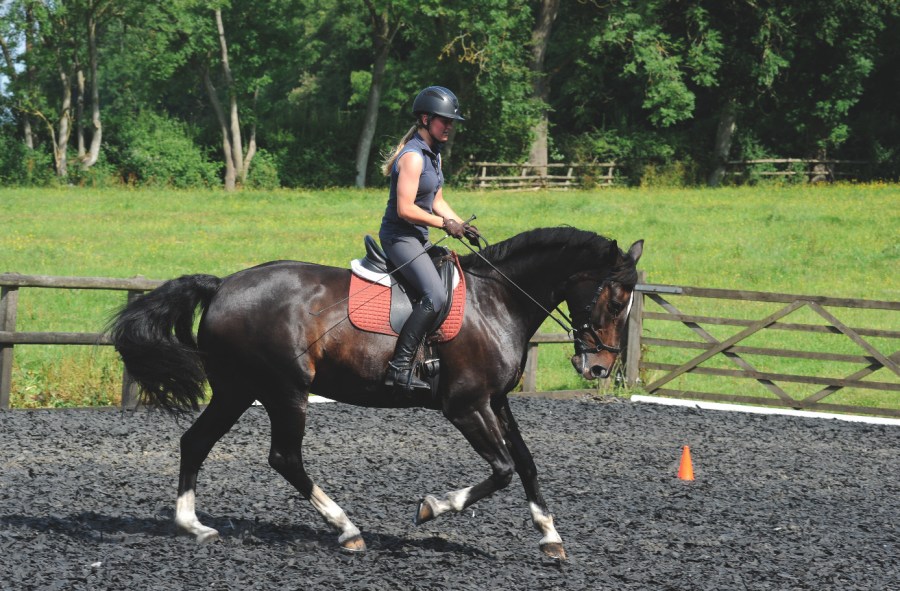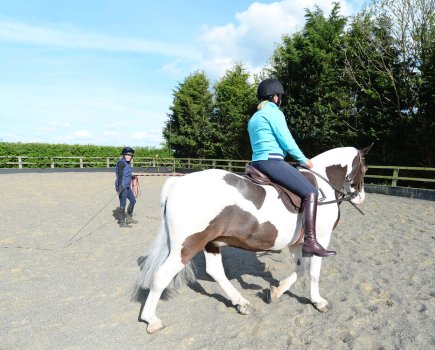Transitions can be tricky things. Ask for too much power and you’ll struggle to get your horse to soften in front and keep a consistent contact through the gears; fail to get enough impulsion and every change of pace will be sticky.
The key is consistency in your training. Your horse needs to be off your leg and working correctly through from behind, so whether you’re asking him to go faster or slower, he’s reactive and balanced.
Nail this at home with three sharpening exercises from dressage judge and coach Nikki Herbert.
Exercise 1: Test His Reactions
Effective transitions stem from effective communication: your aids need to be clear — and your horse needs to be listening.
How to ride it:
- When asking for an upward transition, first use your leg, then be quiet and open the front door to allow your horse forward.
- No reaction? Give him a tap with your stick behind the saddle, then be quiet again.
- This on-off pattern is important. You need to ask your horse to go forward and then see if he replies, but you must always remember to open that front door by allowing him forward with your hand.
- If you get no response, make the aid stronger until he listens.
- Importantly, as soon as you get a reaction, take the pressure off. This is how your horse learns he’s done what you wanted.
- Remember, don’t give your horse lots of pokes, just one clear aid, and always aim to keep him in front of your leg so that he’s thinking and working forward.
Exercise 2: Hone Your Transitions
Once you’ve got your horse awake and listening you can start to fine-tune your gear changes, both up and down.
How to ride it:
- Before asking for a walk-halt transition, make sure the walk is active, with nice regular walk steps.
- Keep your stick in your inside hand to back up your inside leg, as this is the leg that creates impulsion.
- Halt for a couple of seconds, then walk forward again; your horse’s head should be straight in halt, not tilted, so keep the contact even in both hands.
- Next, ask for walk to trot to walk — but just as you feel your horse start to transition to walk, ask him to trot forward again.
- Play around and try asking your horse to go from trot to halt while in a slight shoulder-in position; then go forward to trot again.
- Direct transitions like this (in which you miss a pace out) are a great way to sharpen up your horse’s reactions.
- Next, ask for halt followed by a few steps of rein-back. Simply use your legs a little further back to ‘suggest’ your horse goes back — don’t pull on the reins but keep the conversation softly alive to the mouth.
Exercise 3: Test Your Accuracy
Simple props in the arena, such as cones or poles, can help to give you something to aim for when you’re making a transition up and down and really test how in control you are.
How to ride it:
- Pop two poles parallel to each other on the centre line and ask for halt as you ride between them.
- Play around with this and ride walk to trot, trot to walk and direct transitions between the poles.
- Place two cones at another point in the arena and again ask for a change of pace as you ride between them.
- If your horse starts to anticipate an upward transition, don’t ask for it — ask him to slow down instead.
Meet the expert: Nikki Herbert BHSI (Level 5 Performance Coach) was the National Director of Pony Club training for 16 years and is now a select for Britain’s under-21 dressage teams and the Eventing European Cup CCI3*-S team. She’s an accredited British Eventing Coach, a List 2A British Dressage judge and sits on the BD Judges’ Committee.









